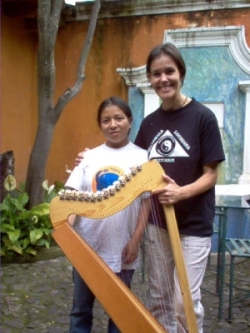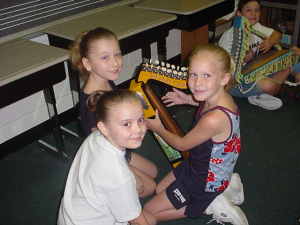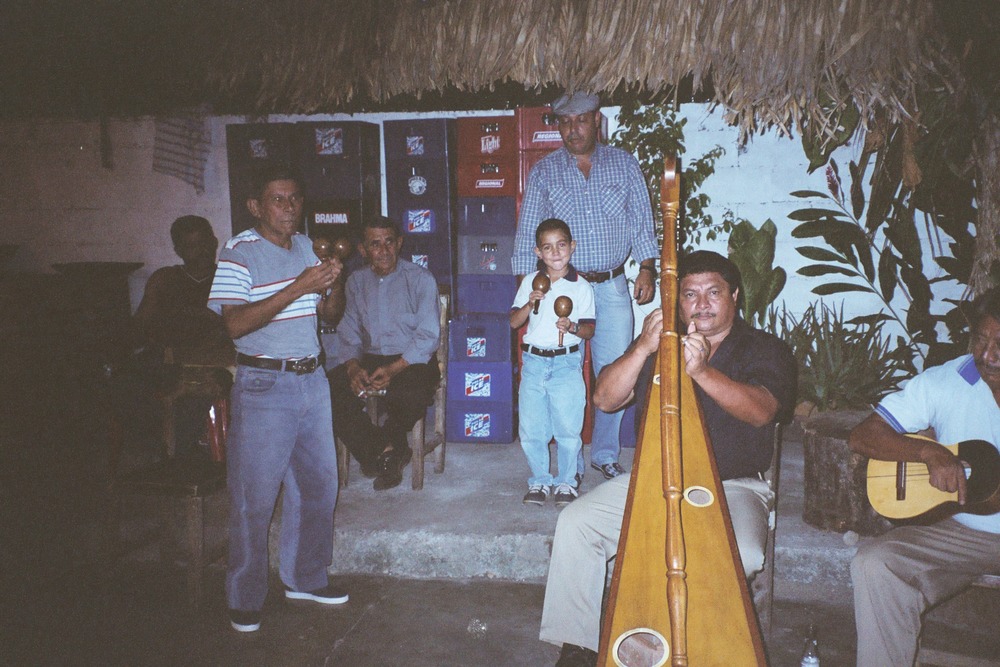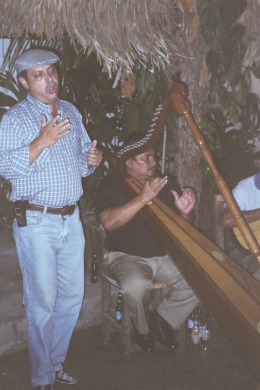- providing harps for week-long workshop at Overbrook School
Christina Cotruvo, of Duluth Minnesota, will be provided with six to eight harps for use during a week-long Braille Music Institute at Overbrook School for the Blind, in Philadelphia, July 17-23. A budget of $500 will provide the means to transport the harps from West Virginia to Philadelphia and back. I am hoping that additional resources may be leveraged through personal networking with the West Virginia School for the Deaf and Blind.
Other projects approved for 2005 are El Molino Harp School and Tegucigalpa Harp School.
(Following are excerpts from Christina's full proposal)
GOAL: To develop harmony and community by integrating the harp with the Summer Braille Music Institute’s School Music Study July 17 through July 23, 2005 at Overbook School for the Blind in Philadelphia, PA for blind children.
WHY: Bring experience of harp to 6 blind music students between the ages of 17- 20 at the music camp who are bound for advanced music study in upper high school grades or beginning college. To use the harp to bond the students and teachers through the harp the first night of gathering and through the week. To learn a new instrument, learn of harp music, feel how harp can heal personally and provide coping skills. To show use of a harp to Philadelphia community volunteers who participate in the seminar. To provide publicity for Harping For Harmony missions.
WHO: Christina Cotruvo – harp, music instructor, and transcriber No-C-Notes Music. Board member CHOICE, unlimited www.choiceunlimited.org. Controller Liscomb-Hood-Mason Co. 2005 Millennium Harper quest filed 3/05 for Harper of Harp-Abilities. 4210 Quebec Ave. Duluth, MN 55804 218-525-9839 E-mail: xina@no-c-notes.com Visit: www.no-c-notes.com David Goldstein, director of National Resource Center for Blind Musicians NRCBM) Music and Arts Center for Humanity (MACH) 510 Barnum Avenue, Third Floor Bridgeport, CT 06608 Phone: 203-366-3300, Extension 229 Email: info@blindmusicstudent.org Visit www.blindmusicstudent.org
The NRCBM is a division of MACH. The resource center provides information and referral services for visually impaired students of all ages, their parents and teachers; learning opportunities for blind students heading to college; and maintains a network of visually impaired musicians willing to share their expertise in braille music, technology and coping strategies. In addition to its Summer Institute seminar, other activities of the resource Center include development of programs for blind children in Connecticut and teacher training.
Past summer seminar students have come from 18 states and 4 countries. Teachers, assistants and volunteers are from Philadelphia and across the U.S.: 2 visually impaired braille music teachers, 2 visually impaired computer teachers, sighted teachers may be hired for theory, individual lessons and ensembles.
WHAT: Summer Braille Music Institute – A Seminar on Braille Music & Technology for School Music Study for 6 blind music students ages 17 – 20 and teacher interns. The summer music camp is in its 10th year and provides individualized instruction in the skills needed for full participation to high school and college theory classes, as well as intensive study of braille music. Days are comprised of classes in braille music, computer, tutoring in theory and related skills, as well as group instrumental and voice activities meant for fun and presentation skills. 2004 summer camp can be viewed at http://blindmusicstudent.org/Summer_Institute.htm *Attached is the 2005 brochure draft.
WHEN: Seminar dates are July 17-23, 2005. Setup on campus by staff will begin July 14. Teachers will arrive July 16 and students July 17. Harp program would begin the evening of Sunday, July 17 to provide bonding activity.
WHERE: The Overbrook School for the Blind, (6333 Malvern Avenue Philadelphia, PA 19151, Telephone: (215) 877-0313, www.obs.org) is on a beautiful campus in Philadelphia, with architecture from the 1890s and a design for today’s needs. School drivers will meet students at the train or airport and provide transportation for any off-campus activities. Facilities are air conditioned, fully staffed with administrative and security personnel. Students and teachers stay in the dorms which also have kitchen and living area. Class rooms are fully equipped for music and computer instruction. Swimming, cookouts, and outings for concerts and recreation in Philadelphia’s cultural centers is also included.
SEMINAR PROGRAM (including harp): Sat. 7/16 – Teacher and assistant training begins Sun. 7/17 – Students arrive in the afternoon. Harp gathering of music and try-it-out instruction will follow dinner. Mon. – Fri. 7/18 thru 7/22: Morning-4 period classes with activity after first 2 classes Lunch and swimming Afternoon-tutoring, ensemble, presenters Wed. Afternoon open house for younger students, family and community. Harps to be part of the open house. Wed. – Fri. Computer braille music notation training by Dancing Dots (DEFINE DANCING DOTS) Evenings and free time: harps are available for use by students. Sat. 7/23 Students and teachers depart
HARP-ABILITIES CHILDREN PROGRAM: Christina Cotruvo is responsible for this proposal, program and harps. Celtic and American folk songs performed by Christina for students and possibly teachers. Q & A session about folk harps and Harping for Harmony Children and teachers receive a harp instrument lesson, how to hold, tune and pluck strings and how to find middle C to find other string tones by ear and by feel and finger position. Scale type of songs to be taught: example the first phrase of “Joy To The World”. Feel of triad chord finger position. How to enjoy! Harps to be available during free time when students are done with homework. Harps to be included in Wed. open house attended by younger students, family and community. HOW: The Summer Seminar is organized and funded by the National Resource Center for Blind Musicians with collaboration of facilities, transportation, and room and board by Overbrook School for the Blind. Christina Cotruvo’s cost: $420 est. harp round trip shipping 400 teacher tuition, room & board 225 airfare round trip from Duluth, MN $1,045 Christina has applied to NRCBM for a seminar paying teacher position to defray costs of airfare and teacher training tuition, room & board. Christina will bring her own lap harp to use. Therefore, this proposal is only for the use of 6 – 8 Rafaella harps and shipping cost estimated at $420.00. Since the size and weight of each package is unknown, only an estimate could be created. *FedEx estimate attached. 6 – 8 Rafaella harps on loan for students and some teachers: $0 Overbrook School for the Blind administrative staff has experience in shipping large items and is willing to handle that. Harps should arrive no later than Sat. 7/16 as there will be no shipping or admin staff on Sun. Harps can be shipped back after the Wed. open house on Thurs. 7/21 or Fri. 7/22. There is on campus security 24 X 7.
SUMMARY: We are VERY excited about the possibility of this proposal and could see it as an annual event. Maybe by next year we’ll be able to have it funded directly by the summer music camp. THANK YOU for your time and effort in helping make this a possibility!
Christina Cotruvo







